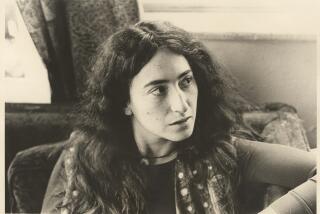De Beauvoir’s Life: A Text of Liberation
- Share via
WASHINGTON — In the late 1940s, Simone de Beauvoir came to the United States for a four-month stay, and wrote about her impressions when she returned to Paris. “In America the individual is nothing,” she reported. “Even the appearance of democracy is disappearing from day to day.” Fascism, she believed, was about to flourish in the United States. And into her old age, she went on believing that the United States was on the verge of capitalist collapse. All her life she remained a committed, dogmatic Marxist, a convinced atheist, a believer that only commitment gave meaning to life.
De Beauvoir was born in Paris, lived her life and died there last Monday at 78 years old. She had studied philosophy at the Sorbonne, taught for a brief time, and then, in 1943, published her first novel “L’Invitee” (translated into English in 1949 as “She Came to Stay”). Her second novel, “The Blood of Others” (“Le Sang des Autres”), published in 1945, was my first contact with existential thought in fiction, my first encounter with characters intellectually inhibited from action and others who heroically faced the absurdity and injustice of life.
De Beauvoir shared her philosophy with her long-time companion, the late Jean-Paul Sartre, whom she met at the Sorbonne in 1929. They lived close but never together; their liaison became a model for modern young couples amid the growing sexual liberation. Her life was full and free: She professed never to have been lonely after she met Sartre. Marriage to her represented a dangerous denial of personal freedom. She had no children, and believed with Sartre that complete sexual freedom was necessary for intellectual and creative life.
De Beauvoir published more than 22 books: Autobiographical memoirs, essays, plays and novels. Her roman a clef , “The Mandarins,” containing portraits of Sartre and Albert Camus, earned for her France’s pre-eminent literary award, the Prix Goncourt, in 1954. But her greatest success was achieved with a book about women which became an international best seller. “The Second Sex” appeared in France in 1949, and in English in 1954. It profoundly affected the burgeoning women’s liberation movement in the United States in the 1960s. It explored historical attitudes toward the place of women in France since earliest times. It provided women with a past and a context for their new ideology, a background from which to understand their feelings of impotence, failure and dependency. It contained a useful and radical (if often depressing and didactic) thesis upon which women could act--act to change the conditions of what society everywhere in the world went on thinking of as the second sex. The New Yorker called the book “more than a work of scholarship; it is a work of art with the salt of recklessness that makes art sting.”
Simone de Beauvoir was a woman of intellectual power and sober persuasion. There is little evidence of humor in her public statements or in her work, perhaps because her view of history was deeply pessimistic and her hopes for a communist future were always disappointed by the events of her lifetime. But she remained a lifelong, committed activist in the cause of political and sexual liberation. Young women, for the rest of this century and perhaps longer, will read her dogmatic but always informed prose, recognize the historic importance of her courageous views on their behalf and understand that in many ways, she was the Mother of Us All.
More to Read
Sign up for our Book Club newsletter
Get the latest news, events and more from the Los Angeles Times Book Club, and help us get L.A. reading and talking.
You may occasionally receive promotional content from the Los Angeles Times.






